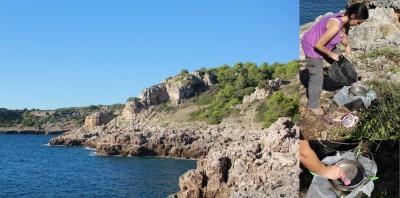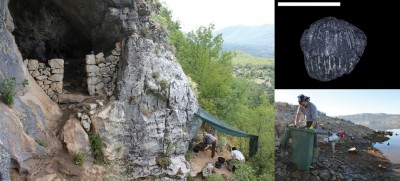The ‘Hidden Foods’ project: new research into the role of plant foods in Palaeolithic and Mesolithic societies of South-east Europe and Italy
Introduction
The ‘Hidden Foods’ project is a new research programme aimed at reconstructing the importance of plant foods in prehistoric forager subsistence in Southern Europe, with a particular focus on Italy and the Balkans. The role of plant foods in pre-agrarian societies remains one of the major issues of world prehistory. Popular narratives still envisage ancient foragers as primarily ‘meat-eaters’, mainly as a consequence of the poor preservation of plant remains in early prehistoric contexts, and due to the employment of methods particularly focused on the contribution of animal protein to human diet (e.g. isotope analysis) (e.g. Bocherens 2009; Jones 2009; Richards 2009). Recently, new methods applied to archaeological evidence have provided a different understanding of hunter-gatherer dietary preference and interaction with the environment. Harvesting and processing might not have been the sole prerogative of agricultural societies, and plant foods seem to have played an important role amongst hunter-gatherers (e.g. Revedin et al. 2010).
Research objectives and methods
The project will investigate different categories of archaeological evidence (ground stone tools, archaeological sediments and human skeletal remains) in order to assess the role of plant foods in prehistoric hunter-gatherers’ diet and health, as well as to explore the causal links between the processing of plant foods and technological changes in artefact production. A suite of methodological approaches will be applied: use-wear analysis; starch granule and phytolith identification; analysis of macro- and micro-botanical remains in archaeological sediments; experimental activities; analysis of dental calculus; and the study of dental pathologies.
Archaeological sediment, stone artefacts and human remains: preliminary investigations
The project commenced in July 2015. The first fieldwork activities have been concentrated in Italy, Croatia and Montenegro. Extensive flotation was carried out at the caves of Cavallo (Italy), Vlakno (Croatia) and Vrbićka (Montenegro) (Figure 1). Soil samples were extensively collected from Upper Palaeolithic (Cavallo Cave) (Figure 2) as well as Late Upper Palaeolithic and Mesolithic (Vrbićka and Vlakno Caves) layers (Figure 3). A large amount of charred plant remains (e.g. seeds, hard shells, parenchyma tissues and so on), and charcoals, were recovered at different sites, highlighting the urgent need to instigate systematic flotation at Palaeolithic and Mesolithic excavations generally. In the coming years, flotation will continue at these sites and new fieldwork is planned in Italy at Bombrini Cave (in collaboration with F. Negrino and J. Riel-Salvatore), Fumane Cave (in collaboration with M. Peresani), Serratura Cave (in collaboration with F. Martini, L. Sarti and D. Lo Vetro) and, in Serbia, at Vlasac (in collaboration with D. Boric) (Figure 1).
Initial research on ground stone tools has focused on the Mesolithic assemblage of the site of Vlasac (Figure 1). Tools discovered in 1970–1971, and during new investigations directed by D. Boric (2006–2009), are under investigation (Figure 4). Traces and residues preserved on the surfaces (e.g. starch granules, plant and animal fibres), and related to the use of the ground stone tools, will be analysed. Future research is planned on Mesolithic artefacts from Icoana, Romania (in collaboration with C. Bonsall and A. Boroneant), as well as on ground stone tools from several Upper Palaeolithic/Mesolithic sites in Italy (e.g. Dalmeri Rockshelter, Serratura and Romito Caves), Croatia (Vlakno Cave) and Montenegro (Vrbicka Cave and Crvena Stijena) (Figure 1).
Research on human dental calculus has started with the analysis of individuals recently excavated at Vlasac, dated to the Late Mesolithic and the Mesolithic–Neolithic transition phase (Figures 5 & 6). Starch granules found in large numbers in dental calculus indicate that Holocene forager diet was more balanced than previously thought and included different species of grasses of the Poaceae family (Cristiani et al. in press). Mesolithic dental calculus from individuals buried at Mondeval de Sora (Italy) and Vlakno Cave are currently under investigation.
Finally, a collaboration with the Botanical Gardens of Belgrade (Serbia) and Cambridge (UK) was started with the aim of assembling modern edible and medicinal plants native to the central Balkans and the Mediterranean region, as well as non-dietary items (e.g. plants used for cordage). This collection will be developed during the project and made available as a reference resource for other archaeological projects.
Further details of the project are available at: www.hiddenfoods.eu (accessed 17 May 2016).
Acknowledgements
The authors express their very great appreciation to the European Research Council for funding the ‘Hidden Foods’ project.
References
- BOCHERENS, H. 2009. Neanderthal dietary habits: review of the isotopic evidence, in J.-J. Hublin J.-J. & M. Richards (ed.) The evolution of hominid diets: integrating approaches to the study of Palaeolithic subsistence: 241–50. New York: Springer.
- CRISTIANI, E., A. RADINI, M. EDINBOROUGH & D. BORIC. In press. Dental calculus reveals Mesolithic foragers in the Balkans consumed domesticated plant foods. Proceedings of the National Academy of Sciences of the United States of America.
- JONES, M. 2009. Moving north: archaeobotanical evidence for plant diet in Middle and Upper Paleolithic Europe, in J.J. Hublin & M. Richards (ed.) The evolution of hominid diets: integrating approaches to the study of Palaeolithic subsistence: 171–80. New York: Springer. http://dx.doi.org/10.1007/978-1-4020-9699-0_12
- REVEDIN, A., A. ARANGUREN, R. BECATTINI, L. LONGO, E. MARCONI, M. MARIOTTI LIPPI, N. SKAKUN, A. SINITSYN, E. SPIRIDONOVA & J. SVOBODA. 2010. Proceedings of the National Academy of Sciences of the United States of America 107: 18815–19. http://dx.doi.org/10.1073/pnas.1006993107
- RICHARDS, M.P. 2009. Stable isotope evidence for European Upper Paleolithic human diets, in J.J. Hublin & M. Richards (ed.) The evolution of hominid diets: integrating approaches to the study of Palaeolithic subsistence: 251–57. New York: Springer. http://dx.doi.org/10.1007/978-1-4020-9699-0_20
Authors
* Author for correspondence.
- Emanuela Cristiani*
McDonald Institute for Archaeological Research, University of Cambridge, Downing Street Cambridge CB2 3ER, UK (Email: ec484@cam.ac.uk) - Anita Radini
BioArCh, University of York, King’s Manor, York Y01 7EP, UK (Email: anita.radini@york.ac.uk) - Dušan Borić
Department of Archaeology and Conservation, SHARE, Cardiff University, John Percival House, Colum Drive, Cardiff CF10 3EU, UK (Email: boricd@cardiff.ac.uk) - Giuseppina Mutri
McDonald Institute for Archaeological Research, University of Cambridge, Downing Street, Cambridge, CB2 3ER, UK (Email: gm461@cam.ac.uk) - Dragana Filipović
Institute for Balkan Studies, Serbian Academy of Sciences and Arts, Knez Mihailova 35/IV, 11000 Belgrade, Serbia (Email: drfilipovic12@gmail.com) - Ethel Allué
The Catalan Institute of Human Paleoecology and Social Evolution (IPHES), C. de l’Escorxador, s/n 43003 Tarragona, Spain (Email: eallue@iphes.cat) - Clive Bonsall
School of History, Classics and Archaeology, University of Edinburgh, William Robertson Wing Old Medical School, Teviot Place, Edinburgh EH8 9AG, UK (Email: clive.bonsall@ed.ac.uk) - Adina Boroneanţ
Institute of Archaeology ‘Vasile Pârvan’, 11 Henri Coandä Strada, 010667 Bucharest, Romania (Email: boro30@gmail.com) - Giampaolo Dalmeri
MUSE—Museum of Sciences of Trento, Corso del Lavoro e della Scienza 3, 38122 Trento, Italy (Email: giampaolo.dalmeri@muse.it) - Federica Fontana
Department of Human Studies, University of Ferrara, Corso Ercole I d’Este 32, I-44100 Ferrara, Italy (Email: federica.fontana@unife.it) - Domenico Lo Vetro
Department SAGAS, University of Florence, Piazza Brunelleschi 3–4, 50121 Firenze, Italy (Email: domenico.lovetro@unifi.it) - Fabio Martini
Department SAGAS, University of Florence, Piazza Brunelleschi 3–4, 50121 Firenze, Italy (Email: fabio.martini@unifi.it) - Fabio Negrino
Department DAFIST, University of Genoa, Via Balbi 2, 16126 Genova, Italy (Email: fabio.negrino@unige.it) - Marco Peresani
Department of Human Studies, University of Ferrara, Corso Ercole I d’Este 32, I-44100 Ferrara, Italy (Email: psm@unife.it) - Julien Riel-Salvatore
Department of Anthropology, University of Montréal, Pav. M.Caron-L.Groulx-3200 J.B. \ Ext. C-3026, Canada (Email: julien.rielsalvatore@umontreal.ca) - Lucia Sarti
Department of History and Cultural Heritage, University of Siena, via Roma 56, Siena, Italy (Email: lucia.sarti@unisi.it) - Dario Vujević
Department of Archaeology, University of Zadar, Obala kralja Petra Krešimira IV. 2 HR-23000, Zadar, Croatia (Email: dario.vujevic@gmail.com) - Snežana Vukojicić
Institute of Botany and Botanical Garden Jevremovac, Faculty of Biology, University of Belgrade, Takovska 43, 11000 Belgrade, Serbia (Email: sneza@bio.bg.ac.rs)







 Cite this article
Cite this article